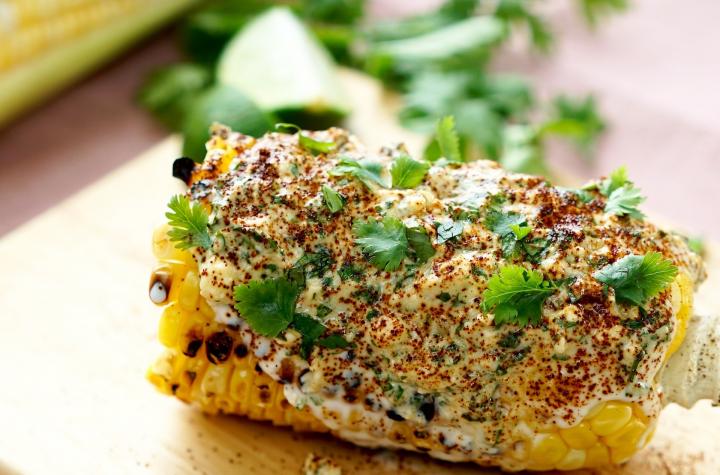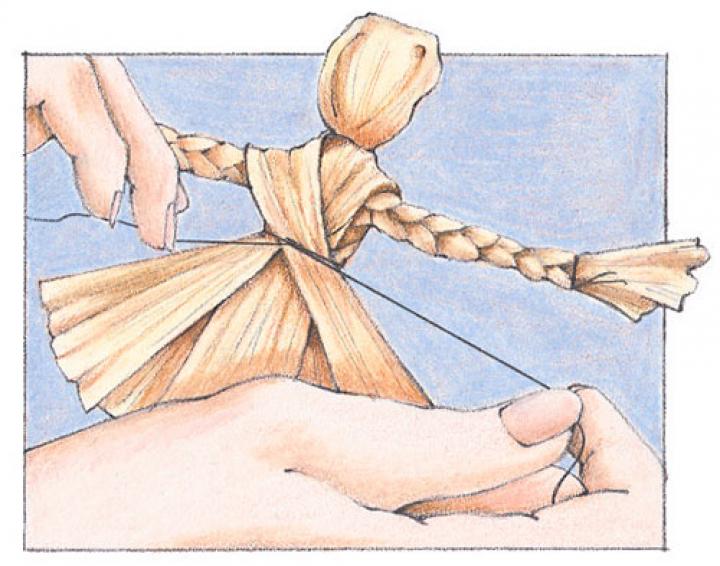Hurrah! It’s corn-on-the-cob season across the nation, and I grew a few rows of corn this year. Corn is great for eating, but its many other uses range from crafts to medicine. Discover how to use the entire ear, including the kernels, husks, silks, and cob, to make delicious recipes in the kitchen, natural remedies to heal, fun crafts, and more.
Corn’s On!
For me there’s nothing like plopping an armload of just-picked-and-husked corn into a pot of boiling water for a few minutes and gobbling a few ears plain or with salt and butter!
Other favorites are a grilled Mexican street corn, summer corn salad, and corn chowder.
Of course, fresh corn only lasts so long, so the next best thing is to freeze it! Freezing corn is a little messy, but it’s not hard at all. (And, yes, you must blanch it!) Wouldn’t it be divine to have the taste of summer come January? See how to freeze corn.
 Recipe photo: Grilled Corn. The creamy chili-lime butter brings out the crunchy, grilled flavor.
Recipe photo: Grilled Corn. The creamy chili-lime butter brings out the crunchy, grilled flavor.
Corn is the only native American grain, cultivated by Central American natives for at least 7,000 years as one of the “three sisters”—corn, beans, and squash—of native American agriculture. The cornstalks grew tall and supported the climbing beans, while the squash rambled out across the ground, helping retain soil moisture and suppress weeds. See this Almanac article on how to grow the three sisters.
Corn is our most widely grown crop, with more than 90 million acres in production nationwide, yielding as much as 13 billion bushels annually. Although most of the crop is used to feed livestock, about 40 percent is diverted for production of ethanol, and most of that is used as a gasoline additive.
Besides eating corn kernels or feeding it to livestock, corn-centered cultures have long used every part of the plant, and we can, too.
Corn Silk
Corn silk, that handful of long strands hanging from the ear and so devilishly difficult to remove from the fresh kernels (I use a soft toothbrush), has a long history of use as a medicinal herb and in many cosmetics.
- For millennia, traditional healers have relied on fresh or dried corn silk as a diuretic, a treatment for kidney, bladder, and urinary tract infections, an anti-inflammatory, and a gentle treatment for high blood pressure, bedwetting, prostatitis, and diabetes. I’ve known folks who found relief with corn-silk tea after long-term battles with cystitis, including repeated doses of various antibiotics and other medicinal herbs. However, as you should with any home remedy, especially for a serious health problem, discuss this treatment with your professional health practitioner before you experiment with corn silk.
- You’ll also find corn silk in many face and body powders, as well as hair-conditioning products. Here’s a recipe for a nice hair rinse and conditioner:
Make a strong infusion of ½ cup of chopped fresh corn silks in a pint of water by bringing to a boil, then simmering for five minutes and letting steep until cool. Add half a teaspoon of mild food-grade oil—olive, coconut, peanut, almond, or grapeseed—and a few drops of your favorite essential oil (rose, rosemary, lavender, etc). Put the mixture in a spray bottle and spray your hair after washing. No need to rinse.
What about corn silk for a more nutritious, cheaper burger? A fascinating Malaysian study, “Cornsilk Improves Nutrient Content and Physical Characteristics of Beef Patties,” found that adding ordinary cornsilk, dried and ground, to beef patties resulted in a higher-protein, lower-fat burger whose taste was no different from the regular burger.
Corn Husks
Native Americans made dolls and other children’s toys from corn husks, and wove the husks into mats, baskets ropes, moccasins, and ceremonial masks.
Creative folks use the husks to make all sorts of gorgeous, durable crafts, such as wreaths. Use your imagination!
 Image: See how to make a cornhusk doll!
Image: See how to make a cornhusk doll!
Serious cooks know corn husks best as wrappers for traditional Central- and South-American tamales, husks stuffed with savory or sweet fillings, then steamed (like stuffed grape leaves or cabbage rolls). Corn husks are sold dried for this purpose, then steamed to soften them before use.
But this summer, as soon as my corn is ripe, I plan to try this recipe for uchepos, special tamales using fresh husks and fresh corn scraped from the cob. You can add all sorts of ingredients to the filling (including dessert ingredients), but I like this recipe for its simplicity.
Corn Cobs
Dried, ground corncobs are used as abrasive agents (even in cosmetics, e.g., in exfoliants), as fuels, for livestock bedding, and for making industrial chemicals.
But even the few you may be generating as you eat your way through fresh-corn season are worth saving for re-use.
- Corn cobs simmered in water (with or without herbs and other kitchen scraps) make an incomparably rich soup stock. Use all you make for a big soup or chowder, or freeze it for later use. Your stock may even possess health-promoting properties.
- Corn-cob jelly, a tradition in many corn-growing parts of the nation, goes well with homemade corn bread. Use this tested recipe. It’s sweet as candy, though, so go easy on the serving size.
- Homemade corn whiskey, aka moonshine (which is, of course, illegal), isn’t the only tipple old-time homesteaders learned to make using corn. Here’s a simple recipe for corn-cob wine, using only the leftover cobs, water, yeast, and sugar.
Corn Meal
Finally, here are a few uses (and not-so-good uses) for ordinary corn meal
- Dry and preserve fresh flowers. Mix equal parts corn meal and borax in an uncovered shoebox or other container. Bury the flowers in the mixture for three weeks or until the flowers dry.
- To remove odors and freshen carpets, sprinkle a 2:1 mixture of cornmeal and borax over the carpet, let stand for an hour or more, then vacuum.
- Entertain young children with a cookie sheet, pizza pan, or larger surface scattered with cornmeal. They enjoy tracing swirls and shapes with their fingers, and pushing small trucks, animals, or action figures around in the cornmeal “desert.”
- Cure for toenail fungus or athlete’s foot? Many people swear by it, but I’ve seen no research-based evidence for it. Seems harmless enough for a try.
- Corn gluten as a safe, effective herbicide? No.
- Cornmeal as a safe and effective garden fungicide? Probably not.
If you’re interested in growing corn in the garden, see the Almanac’s Guide to Growing Corn for great information!


 Recipe photo:
Recipe photo:  Image:
Image: 






